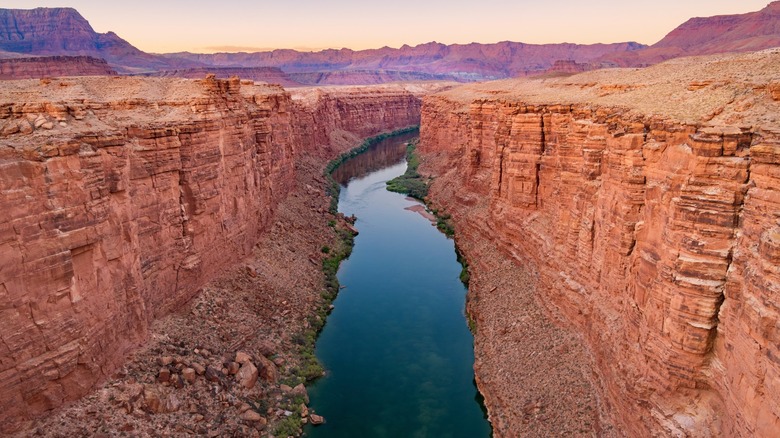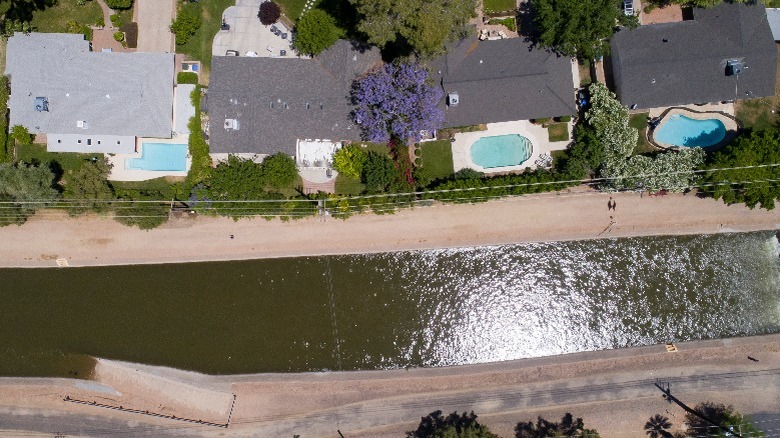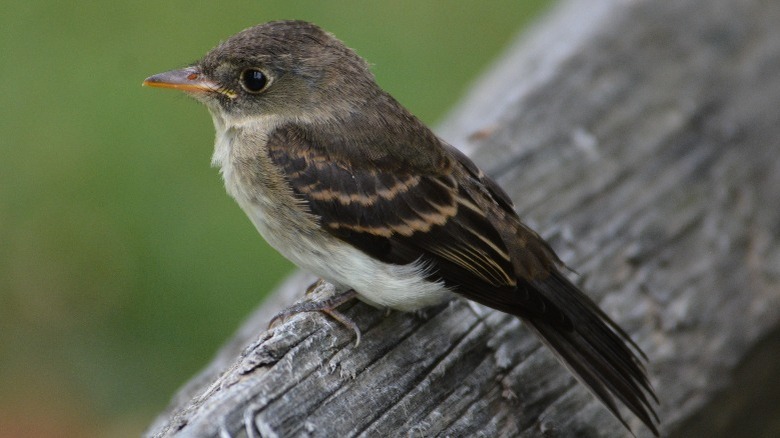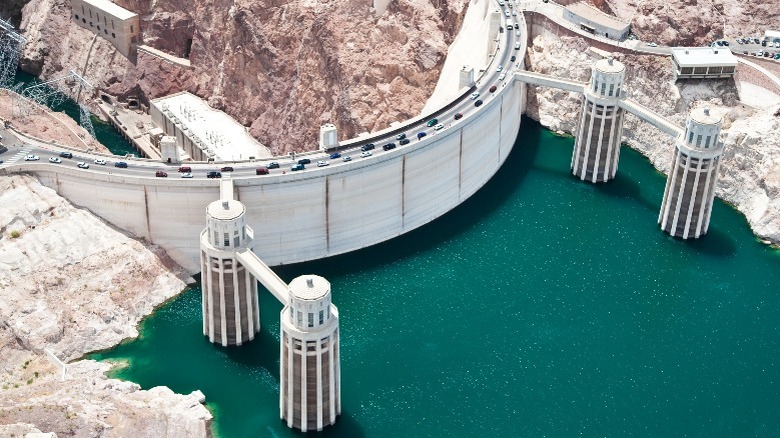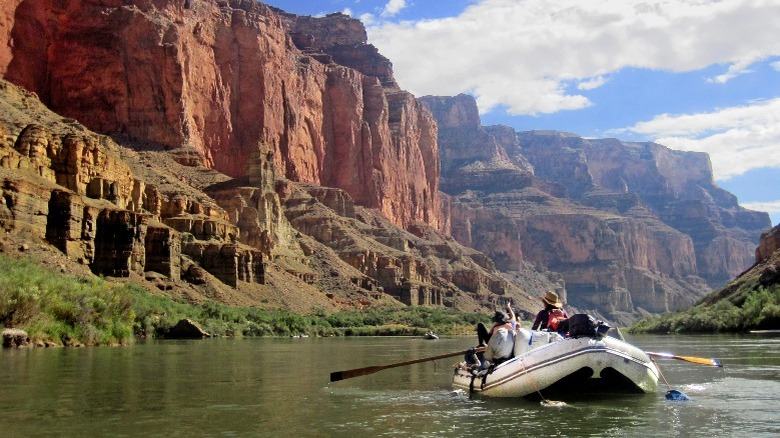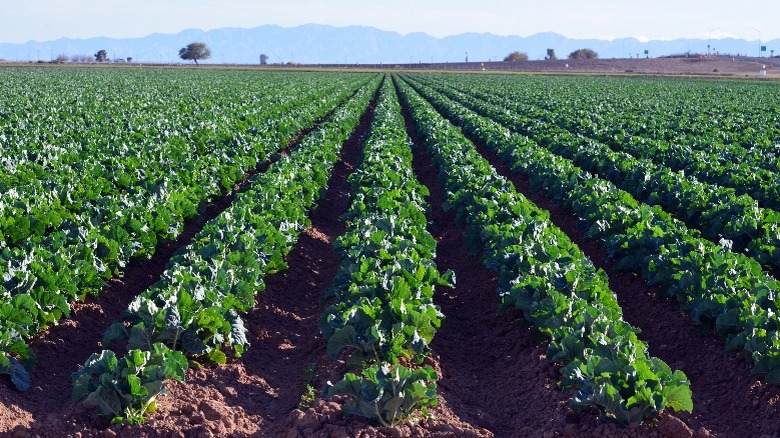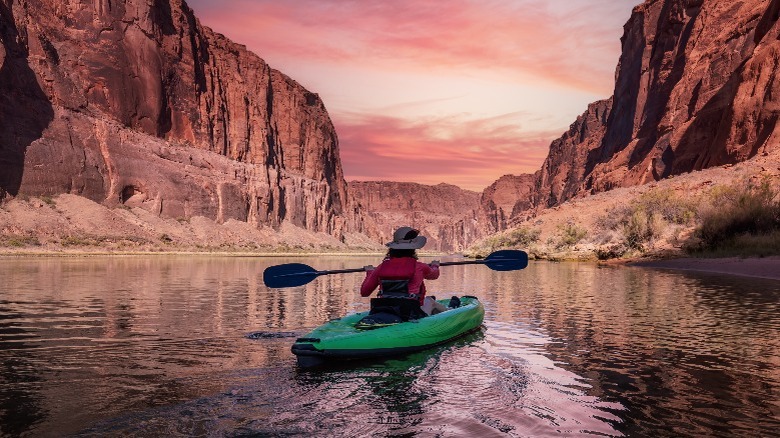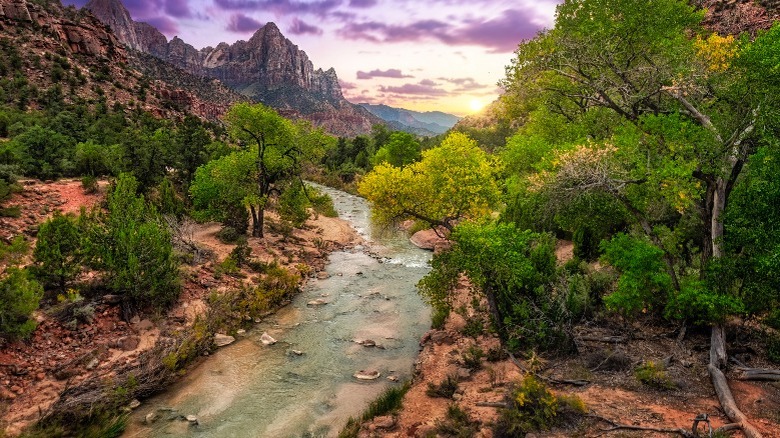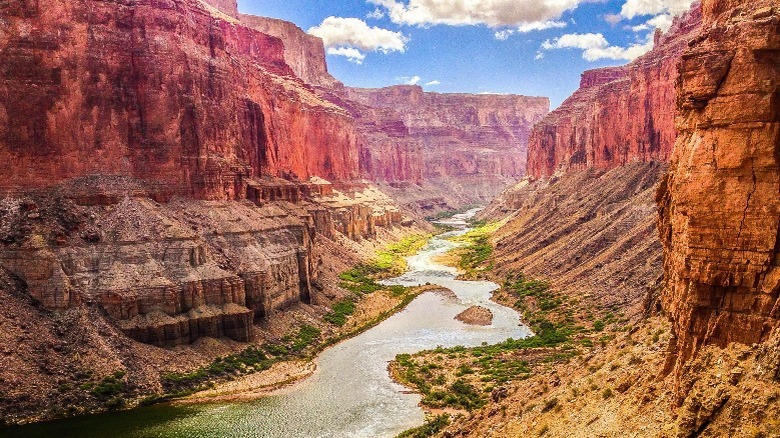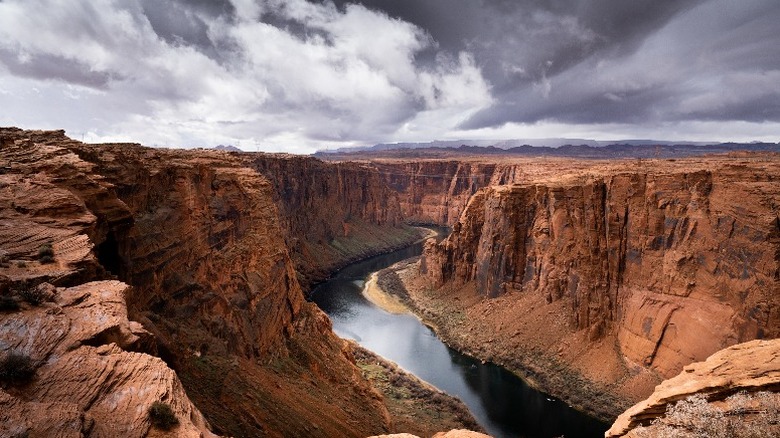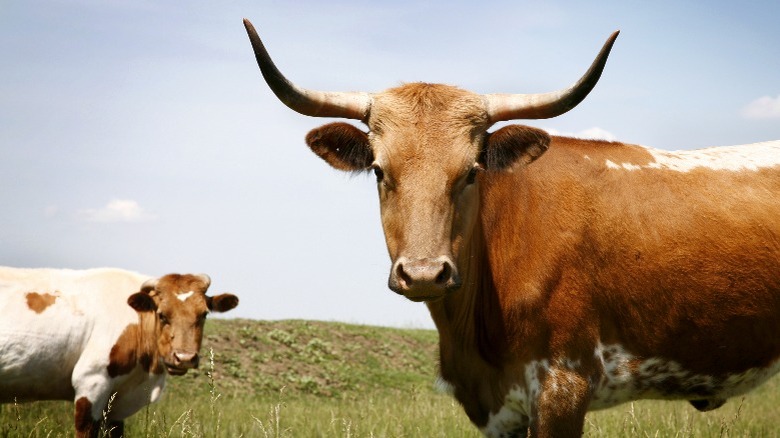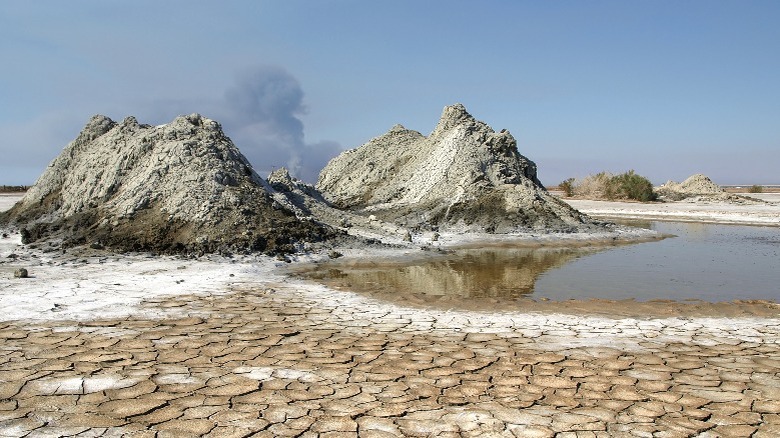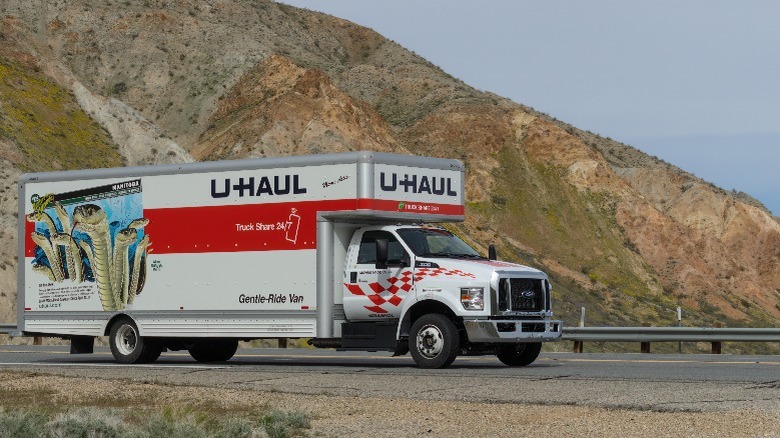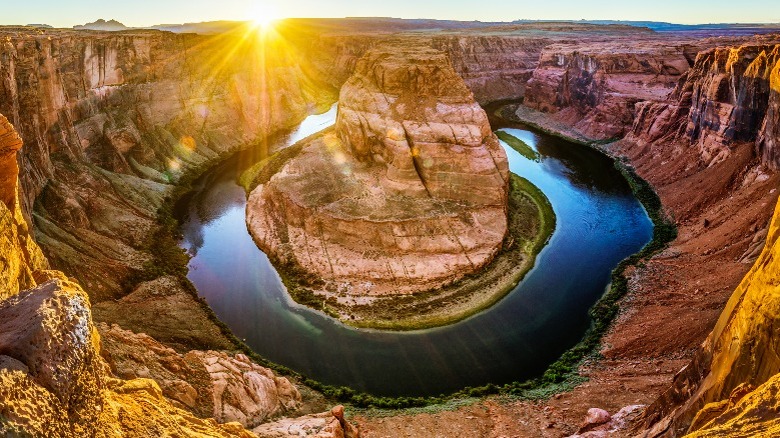What Happens If The Colorado River Dries Up Forever?
Starting as snowmelt high in the Rocky Mountains, the Colorado River flows south through the arid western United States, its tributaries extending outward to provide much-needed water for Wyoming, Colorado, Utah, Nevada, New Mexico, Arizona, and Southern California before emptying into northwestern Mexico's Sea of Cortez. At 1,450 miles long, "The American Nile" is the sixth-longest river in the U.S., its watershed covering an impressive 8% of the country. Called the "Lifeline of the Southwest," the Colorado River makes life in the parched desert possible for humans, wildlife, and plants alike.
The mighty river also cuts through some of the West's most awe-inspiring landscapes — like Utah's Canyonlands and Arizona's Grand Canyon – and in fact, its waters formed these impressive monuments over the course of its 6-million-year lifespan. But that chapter could be coming to a close. Mismanagement, overuse, and a record drought brought on by the global climate crisis have reduced the river to a fraction of its former glory. Sadly, most years it no longer even reaches the sea.
The once-fathomless Colorado River is now listed as America's most endangered river. With every drop of its water spoken for — and each one used 17 times a year on average — it is one of the earth's most exploited waterways. As the Southern Nevada Water Authority wrote in 2012: "The Colorado River is among the most controlled, controversial, and litigated rivers in the world." With so many lives depending on its water, what would happen if it dried up?
Millions of people would be without water
Living in America's desert southwest is not easy. Yet, humans have been doing it for at least 9,000 years, starting when the Cochise people settled in present-day Arizona and New Mexico. European settlers followed — mainly Mormons, farmers, and prospectors seeking gold – eventually leading to the rapid colonization of the Southwest. And none of this would have been possible without the Colorado River and its many tributaries. Why? Because people need constant access to water to survive.
In 1922, citizens from the seven states most reliant on the river — Colorado, Wyoming, Utah, Nevada, New Mexico, Arizona, and California — met to discuss how the seemingly endless water supply would be shared. This agreement, known as the Colorado River Compact, determined the percentage of the river's water that each state — and later parts of northwestern Mexico — were entitled to. In the end, California received the biggest percentage of the river's annual output, with the remaining water divided among the six other states and Mexico.
But, of course, if the river dried up, all of these allotments would go to zero. As of 2023, the U.S. Bureau of Reclamation has already cut back water usage amid the river's dwindling supply, and more restrictions will likely be imposed. This is problematic, as the river provides municipal water to several major cities, including Los Angeles, Phoenix, Las Vegas, Salt Lake City, San Diego, and Denver. All told, around 40 million people would be left high and dry.
Many plant and animal species would go extinct
Hundreds of plant and animal species also rely on the Colorado River, many of which are found nowhere else on Earth. Over 400 bird species frequent the river and its tributaries, including the Ridgway's rail and southwestern willow flycatcher (pictured), both already facing extinction. The river's wetland and riparian habitats offer oases in the surrounding desert and serve as important rest stops for migrating species. Losing the river could therefore have a catastrophic impact on the world's already imperiled birds.
The Colorado River is also home to 30 species of native freshwater fish uniquely adapted to its warm, silty waters. The addition of some 100 dams to the river system has significantly altered the aquatic environment, cooling its waters, disrupting its natural flow, and lowering its silt content. As a result, many of these fish — like the razorback sucker, humpback chub, and desert pupfish – are already endangered. If the river dried up, they would certainly go extinct along with it.
The relict leopard frog, desert tortoise, and cottonwood trees are just a few of the other species that would suffer without the Colorado. Its demise would have far-reaching effects, even contributing to the continued decline of the vaquita – considered the rarest animal in the world – whose survival depends on the Colorado River Delta's freshwater influx. As Save the Colorado's Gary Wockner told The Revelator: "As you drain the river, you drain the life off the land that depended on that water."
It would disrupt the western electrical grid
In addition to supplying water, the Colorado River also adds over 4,200 megawatts of hydroelectric power to the Southwest's electrical grid through two of America's biggest dams by volume: Glen Canyon Dam and Hoover Dam. Situated above two massive reservoirs – Lake Powell and Lake Mead, respectively — the dams generate energy by first pooling a large stock of water, then allowing it to flow through intakes within the structure. This then spins a series of turbines connected to generators and produces the electricity that powers the homes of about 4 million people.
Lake Powell and Lake Mead are the largest reservoirs in the United States. Yet, as of 2023, both are already alarmingly close to dipping below "power-pool level," the minimum point at which water can pass through the dams, spin the turbines, and generate hydroelectric power. If the Colorado River — which keeps the reservoirs full and the dams operational — were to stop flowing, both dams would cease contributing hydroelectricity to America's power grid.
The U.S. power grid is a convoluted network that relies on multiple energy sources to function. While the West likely wouldn't outright lose electricity if it were disrupted, removing 4,200 megawatts of hydroelectric power from the system would certainly complicate matters. It would also increase the grid's reliance on burning fossil fuels to generate power, which would in turn produce more destructive carbon emissions and further escalate the climate crisis. It could also cause utility bills to skyrocket.
Many people would lose their jobs
As if supplying water and hydroelectric power wasn't enough, a surprising number of people also depend on the Colorado River for employment. According to a 2014 report published by Arizona State University, the river supports 16 million jobs in the states of California, Arizona, Nevada, Wyoming, Utah, New Mexico, and Colorado, all in all bringing in about $1.4 trillion to the American economy each year.
While jobs like farming and river raft guiding would naturally evaporate along with the river, plenty of other, less obvious vocations would also be negatively impacted. As the study notes, jobs in real estate, technology, finance, healthcare, social services, and retail would suffer the most. For example, Arizona's billion-dollar semiconductor industry – which provides tens of thousands of jobs in Phoenix — would tank without the river to supply the large volume of water necessary to cool chip manufacturing equipment and carefully clean thousands of silicon wafers.
And it's already happening. As of 2023, the U.S. Bureau of Reclamation's proposed water use cutbacks have the potential to impact the seven states reliant on the Colorado River significantly, with the most extreme action plan resulting in the collective loss of over $637 million in income and around 9,900 jobs. "It is our livelihoods," author and explorer Jonathan Waterman wrote in National Geographic. "I have friends who depend on the river for their work as boatmen, fishing guides, defenders of water rights, teachers, photographers, hay growers, farmers, and realtors."
Agriculture would be impacted worldwide
When pioneers first settled in the American Southwest, agriculture was strongly encouraged. Owing to the desert's year-round sunlight, growing a variety of plants, including wheat, cotton, and citrus, was relatively easy, so long as soil nutrients and water were added. Naturally, the settlers looked to the seemingly endless bounty of the Colorado River. Throughout the Southwest, they dug irrigation canals and created a thriving and elaborate agricultural system that now adds over $60 billion to the American economy each year.
But there's a huge problem: Growing non-native plants in the hot and dry desert Southwest requires a ton of water. As of 2023, an unbelievable 70% to 80% of the Colorado River's water supply goes toward irrigating over 5.5 million acres of farmland, mostly located in the desert. Of this, around 70% consists of water-intensive alfalfa and other crops used to produce livestock feed for the beef and dairy industries, that is shipped all over the world.
In addition, over 90% of the United States' winter vegetables — including broccoli, carrots, spinach, lettuce, and kale — come from California's Imperial and Coachella Valleys and Yuma, Arizona, all watered by the Colorado River. If the river runs completely dry, this region would lose access to over 3.5 million acre-feet of water each year, making farming impossible. "Where are you going to have a Caesar salad in February?" Imperial Valley farmer Jack Vessey asked Vox, adding, "If the Colorado River isn't growing produce, good luck."
Popular recreational areas would go by the wayside
Viewed as it so often is in a strictly utilitarian sense — mainly as a reliable source of water, electricity, food, and employment — it can be easy to overlook some of the Colorado River's other offerings, like its immense natural beauty and the diverse opportunities for recreational enjoyment it affords. But these seemingly frivolous functions are far more important than many realize.
Four national recreation areas occur within the Colorado River system: Utah and Wyoming's Flaming Gorge, Colorado's Curecanti, Utah and Arizona's Glen Canyon, and Arizona and Nevada's Lake Mead. Of these, the Lake Mead National Recreation Area is the largest at 1.5 million acres as well as the first such area ever federally designated. Water-based activities like boating, swimming, whitewater rafting, fishing, kayaking, and waterside picnicking, hiking, and camping abound at all four recreation hotspots, drawing people from all over the world.
It can be hard to quantify the intrinsic value that these recreational areas add to our lives until they're gone — a reality that is guaranteed without the river as their lifeblood. But one thing is certain: Colorado River recreation is a major money-maker. As a 2014 report published by Arizona State University observed, of the approximately $1.4 trillion that the river adds to the American economy each year, a shocking $26 billion comes from recreation alone. In addition, around 250,000 people, from retail staff to river guides to park rangers, rely on Colorado River recreation for work.
Biodiverse riparian habitats would vanish
With their lush green canopies and dense shade, riparian forest ecosystems provide oases for native wildlife and migrating birds in otherwise arid surroundings. While making up less than 2% of the American West's land, these areas act as an important liaison between the aquatic and terrestrial worlds, storing water, removing toxins, and improving soil quality. But, as the Colorado River's flow diminishes, so do these unique habitats.
Drought and overuse of the Colorado River are already taking a toll on the large streamside trees like cottonwoods, sycamores, and willows that line the banks of the river and its tributaries. These trees rely on a constant source of groundwater to thrive within desert environments, and cottonwoods also require heavy flooding to germinate — both of which have been in short supply since the river was dammed. When the big trees die, the river shores lose shade, stability, and vital nutrients. They heat up and dry out, which changes the ecosystem's flora and fauna and degrades the habitat.
It's already happening. But if the Colorado River were to dry up, this extremely biodiverse ecosystem and the many species that rely on it — like the endangered southwestern willow flycatcher — would disappear completely. For a glimpse into the future, we can look to the now-desiccated Colorado River Delta. Once a thriving riparian wonderland that covered around 1.9 million acres, most of the wetland habitat has withered without the river's water, leaving only dusty earth and invasive species in its wake.
The Grand Canyon wouldn't be the same
Arizona's Grand Canyon is one of the world's seven natural wonders — and the Colorado River is its lifeblood. In fact, the river formed the canyon through millions of years of erosion and still flows through it for 277 miles. It's an important part of Grand Canyon National Park, contributing to stunning views both above and below the canyon's walls, fostering cool pools for trout fishing, creating the turbulent rapids beloved by river rafters, serving as a sanctuary for native plants and wildlife, and offering a refreshing respite for hikers and backpackers who venture into the remarkable natural chasm.
Situated between two giant man-made blockades — Glen Canyon Dam above and Hoover Dam below — the canyon's river is already at the mercy of controlled upstream water releases. With continued drought and the prospect of additional water use cutbacks looming, it's entirely possible that this section of the river could be dialed back or even shut off entirely. But if the Colorado River stopped flowing, even temporarily, the Grand Canyon would be a little less grand. The same goes for the 10 other popular national parks that the river and its tributaries flow through, including Utah's Arches, Canyonlands, and Zion national parks and Colorado's Rocky Mountain National Park, where its headwaters begin.
Sites sacred to Indigenous people would be lost
For some, the Colorado River has a significance that extends far beyond its utility. Many Indigenous communities, like the Cocopah, Navajo, and Hualapai, view the Colorado River — and places it encompasses, like the Grand Canyon – as sacred sites. "In the tribal belief system, the river is the life-giver of our people," Loretta Jackson-Kelly, a member of the Hualapai tribe, told The National News. "We as a people believe through our own ancestral stories that we have backbones — you know, our spine, that allows us to live. We feel the same way about the river itself, that it is a living entity." To allow it to dry up would be to extinguish this life force forever.
In northern Mexico, the Cucapá people are already dealing with this loss. Drought and river exploitation has reduced their ancestral home, the once-verdant Colorado River Delta, to dust. Also known as the River People, members of the Cucapá tribe relied on the delta's waters for fish, medicine, housing materials, and spirituality. As of 2019, less than 400 tribe members remained in Mexico, their decline largely due to the delta's demise. "People abandoned the community because there's no river, no fish, and no life here," tribe member Antonia González told The Guardian. "It's cost us our language, culture, and identity." All told, 30 different tribes call the Colorado River Basin home.
Many things would get more expensive
Most of the Colorado River's water supplies irrigation to farmland used to grow leafy winter greens, livestock feed, tree nuts, and other vegetables in the American Southwest. Losing such a large percentage of these key crops would likely cause noticeable price increases in all sorts of unexpected products. Since cattle feed would be in shorter supply, prices of beef and dairy products, like milk and yogurt, would increase. Annual crops like broccoli, lettuce, and tomatoes would also be grown less, meaning they would cost more.
Because water and power would have to be imported from other places — like costly desalination plants on the coast – water and utility bills would also increase for anyone living in the Colorado River Basin, which could make a lot of areas unaffordable for most people. Indeed, utility bill hikes are already a looming reality in states where the U.S. Bureau of Reclamation has imposed water use cutbacks, such as Arizona.
The Colorado River's reach is wider than we realize, and, should it run dry, many people will feel the impact on their pocketbooks. "We eat the river in cheese and beef and vegetables, products that are made with water from the Colorado and then shipped all over the world," author and explorer Jonathan Waterman wrote in National Geographic. "We wear it (as cotton and flax) and condition the air with it, while creating energy with it and growing gardens with it and drinking it in cities far from its banks."
There could be major public health impacts
Following a century of intense farming, the Colorado River has become heavily polluted. According to a 2016 report published by the Surface Water Ambient Monitoring Program, fertilizer nitrates from agricultural runoff, pesticides, selenium, and metals like lead and arsenic have all found their way into the river system. What's worse, these toxic sediments don't just go away when the water dries up. Instead, they take to the air and pose a different sort of public health problem.
Californians living near the Salton Sea — a giant lake on the Colorado River system that has gone from a luxury resort to a stinky wasteland due to high salinity – are already aware of this issue. As a 2019 article published in Science of the Total Environment notes, the drying lakebed's accumulated noxious particles become airborne during high winds, especially common during the Southwest's summer monsoons, peppering the air with toxic dust. Breathing these particles in can cause severe asthma, heart and lung problems, and allergies.
As the Salton Sea evaporates, even more dust is released into the air. And it's expected to get worse. According to a 2014 report published by Pacific Institute, as much as 100 tons of toxic dust could be released per day as it continues to dry up. If the entire Colorado River system were to follow suit, similar health hazards would likely be experienced, particularly in the communities around its two largest reservoirs, Lake Powell and Lake Mead.
A lot of people would probably move
One way or another, living in the American Southwest would be a lot less comfortable without the Colorado River. Water-intensive luxuries like lawns, golf courses, swimming pools, and tropical gardens would go by the wayside. Water and electrical bills would likely be noticeably higher — and that's if either commodity is still available at all. Amid rising temperatures, air conditioning would become simultaneously more essential and less affordable for desert dwellers. To make matters worse, millions of jobs would disappear, and property values would eventually tank.
As a result, many people would likely leave the Southwest in search of a better quality of life in an event reminiscent of the 1930s Dust Bowl. Sadly, it's far from a unique problem. All over the world, people are relocating due to drought and starting over somewhere else as "water refugees." And, according to a 2022 study published in International Migration Review, this trend is expected to increase by a shocking 200% in the coming days as the climate crisis worsens.
It would be very bad news for the Earth
The steady decline of the Colorado River is indicative of a much greater problem: a global climate crisis that is spiraling further and further out of our control. Human-caused temperature increases and the resultant changing weather patterns dictate how much water is available and where, with some areas experiencing catastrophic flooding while others, like the western United States, suffer from extreme drought and rampant wildfires.
Losing a freshwater system as vast and abundant as the Colorado River and its tributaries would be a sure sign of the severe, devastating, and likely irreversible effects of a warming and changing climate creeping dangerously close to — and maybe even past — its critical tipping points. Yet, without intervention and conscious conservation efforts, it's a very real possibility.
"The Colorado River Basin is ground zero for the climate and water crisis," American Rivers' southwest region director Matt Rice stated in a 2022 press release. "The seven Basin states and the Biden administration must work with Tribal Nations and Mexico to act urgently. Failure is simply not an option, given all that depends on a healthy Colorado River."
